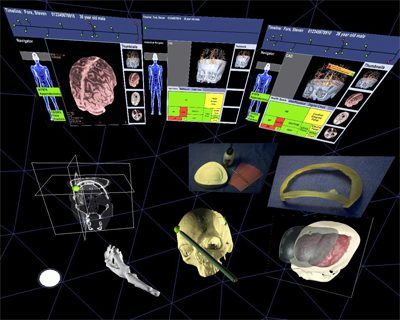CrEdit: Tele-Immersive Cranial Impant Design in a Haptic Augmented Reality Environment
May 1st, 2005
Categories: Applications, MS / PhD Thesis, Tele-Immersion, Virtual Medicine, Visualization, VR

Authors
Scharver, C.About
Repairing severe human skull injuries requires customized cranial implants, and current visualization research aims to develop a new approach to create these implants. Following pre-surgical design techniques pioneered at the University of Illinois at Chicago (UIC) in 1996, researchers have developed an immersive cranial implant application incorporating haptic force feedback and augmented reality. The application runs on the Personal Augmented Reality Immersive System (PARIS℠), allowing the modeler to see clearly both his hands and the virtual workspace. The strengths of multiple software libraries are maximized to simplify development. This research lays the foundation to eventually replace the traditional modeling and evaluation processes.
Today a medical sculptor utilizes anatomical modeling expertise to sculpt a prosthetic implant. However, even with the aid of automated manufacturing techniques, the design process poses several problems. Techniques developed at the UIC in 1996 have greatly improved the practice. This thesis aims to augment these techniques using a new virtual reality display system and customized software tools. Involving extensive planning during the pre-surfical design process, closing large cranial defects offers patients therapeutic benefits. These benefits include restoring the shape of the head, protecting vital brain tissue, minimizing pain, reducing operating and recovery times, and in some cases improving cognitive capabilities. Unfortunately, several factors limit cranial implant availability. Insurance companies often will not support this form of reconstruction due to the high labor and material costs.
Because only neurosurgeons and medical modelers possess the specialized anatomical knowledge, assembling the necessary expertise is difficult. Travel expenses for both patients and specialists increase the overall cost. Currently acrylic polymer is the most commonly used implant material. When used intra-operatively, the material exudes extreme heat as it solidifies. Exposing the brain to these temperatures can cause tissue damage. For this reason, it is vital that implant design and fabrication takes place prior to surgery.
Traditional cranial implant fabrication and surgical placement methods are heavily dependent on subjective skills and procedures requiring specialized knowledge. The cranium’s anatomical complexity impedes reconstruction without extensive planning. Additionally, the implant design must take into account features unique to the patient. Pre-surgical cranial implant design and fabrication alleviates many of these shortcomings.
The 1996 UIC approach incorporated a series of expensive manual manufacturing steps to produce a custom-fitting implant. These techniques serve as a guide for implementing a digital approach combining augmented reality and haptics. Medical sculptors are trained using their hands, and their abilities are heavily dependent on that fact. The awkward control devices used by traditional VR systems are not conducive to intricate sculpting techniques. Introducing force feedback allows the user to feel the virtual defect and implant models, giving the user the sense of touch that is important for 3D modeling (Massie, 1998). The design process also requires medical sculptors clearly see their hands while modeling an implant. Using augmented reality we can combine real and virtual information, allow real time interactivity, and manage 3D registration (Azuma, 1997).
This thesis centers around mutual interests between UIC’s EVL and Virtual Reality in Medicine Laboratory. Force feedback robots often operate adjacent to associated displays, but this mode of operation is non-intuitive for medical sculptors accustomed to directly working with physical models. By combining graphics and haptics, this thesis presents a prototype environment for examining cranial implant design. CrEdit presents an augmented reality environment combining sensory feedback, established by the following purposes:
- Integrate PHANToM haptics with AR
- Load medical data into 3D environment
- Examine tools required by medical sculptor
- Follow existing interaction metaphors
- Provide foundation for future research
Resources
Citation
Scharver, C., CrEdit: Tele-Immersive Cranial Impant Design in a Haptic Augmented Reality Environment, Submitted as partial fulfillment of the requirements for the degree of Master of Computer Science, Graduate College, University of Illinois at Chicago, Chicago, IL, May 1st, 2005.